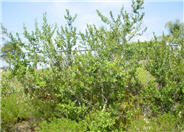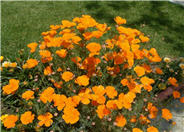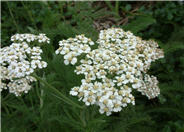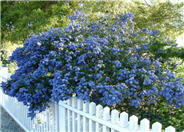
Common name:Lemonade Berry
Botanical name:Rhus integrifolia
The Lemonade Berry is an evergreen shrub that reaches 30' high. It has aromatic leaves and develops small white to pink flowers and red berries. This shrub grows best in coastal areas and is drought tolerant. The Lemonade Berry is a native to California

Common name:California Poppy, Golden Poppy
Botanical name:Eschscholzia californica
This small annual (sometimes acts as a perennial) plant will grow to less than 1' tall and has light, small blue green leaves with gold and orange flowers that bloom in spring and summer.

Common name:Yarrow
Botanical name:Achillea millefolium
This Achillea features spreading mats of fern-like rosettes, along with deeply divided leaves of a green or gray green color. In this form, the flowers are usually a white tone. Stems can reach 2'-3' above foliage. Yarrows propagate easily from rooted cuttings or division, which should be performed in the early spring or fall. Following bloom, one should dead head the plant and divide the clumps when it appears crowded.

Common name:Concha California Lilac
Botanical name:Ceanothus 'Concha'
Concha is a lilac that grows 6'-8' in height and width. It has small narrow leaves with intense dark blue flower clusters in spring. It is tolerant of coastal and inland conditions.

Common name:Columbine
Botanical name:Aquilegia hybrids
Coumbine has large, spurred flowers with clear colors of white, lavender, yellow, deep red and pink which are borne on 2 1/2' tall plants. The strikingly beautiful blooms make good cut flowers. They require partial shade or full sun, along with well- drained soil. The colors, however, cannot be chosen.
| Designer: Dave Buchanan | Raised Garden Beds |
Photographer: GardenSoft |
Soils and Compost:
Maintain a two to four inch layer of mulch on the soil surface to reduce weeds, infiltrate rain water, and reduce compaction.
Water Saving Tip:
Check your irrigation system for breaks, leaks and problems once a month.
Integrated Pest Management:
Remove irrigation water and fertilizer from areas where you don't want weeds to grow.

